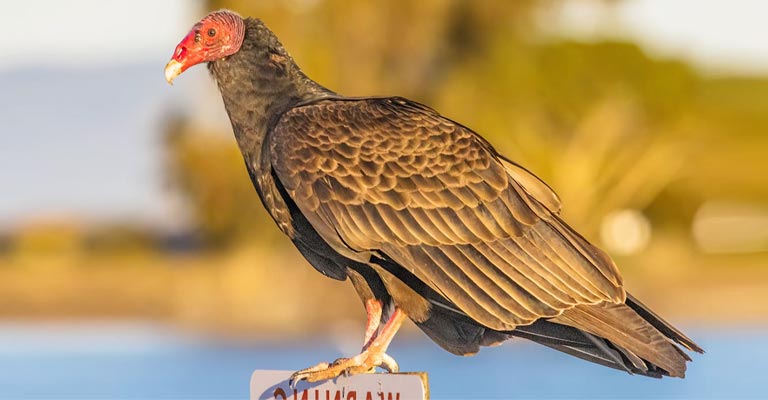The sight of numerous buzzards soaring high in the sky, swirling on thermal currents and circling in large numbers, is a mesmerizing natural spectacle.
But what prompts these raptors, often known as hawks in North America, to gather in such impressive congregations?
The phenomenon of buzzards forming large groups is a captivating glimpse into the intricacies of their behavior and social dynamics. To comprehend why buzzards gather in such a manner, we delve into a world of avian behavior and ecology.
In this exploration, we uncover why do buzzards gather in large groups, from the practical advantages they confer to the vital social interactions that take place.
The reasons behind the phenomenon shed light on the adaptability and intelligence of these birds, as well as the profound impact of environmental and ecological conditions on their behaviors.

Why Do Buzzards Gather In Large Groups?
Buzzards, often referred to as hawks in North America, are known for their tendency to gather in large groups, especially during migration or when soaring. Here are the reasons why buzzards congregate in such groups:
Thermals and Updrafts
One primary reason for buzzards gathering in large groups is to take advantage of thermals and updrafts. These rising columns of warm air provide buoyancy and lift, allowing buzzards to soar effortlessly.
By soaring together, they can save energy and cover vast distances during migration or while searching for prey.
Increased Vigilance
Buzzards are social birds to some extent, and grouping enhances vigilance. More eyes scanning the surroundings means a better chance of spotting potential predators or scavenging opportunities. Safety in numbers is a strategy to reduce the risk of predation.
Sharing Information
Buzzards often share information about food sources. When one buzzard locates carrion, the others quickly pick up on this discovery and converge on the site. This collective foraging strategy increases their chances of finding and accessing food.
Social Bonding
Gathering in large groups also serves a social function, fostering bonds among individuals. These gatherings may help young buzzards learn from more experienced members of the group, including foraging techniques and migratory routes.
Mating and Courtship Displays
During the breeding season, buzzards engage in elaborate courtship displays. These displays are often more impressive when performed in larger groups. Males use soaring and acrobatics to attract females, and group gatherings can make these displays more impressive and competitive.
Learning Opportunities
Young buzzards often join these large gatherings to learn vital survival skills from older, more experienced individuals. By observing and interacting with older members, they can acquire knowledge about foraging, hunting, and navigation.
Resource Abundance
In some regions, buzzards gather in groups due to the presence of abundant resources, such as food or favorable thermal conditions.
The collective presence of numerous buzzards in one area can be indicative of a rich environment, prompting others to join in for these benefits.
Buzzards gather in large groups for a combination of practical reasons, including thermals, vigilance, information sharing, social bonding, mating displays, learning opportunities, and the presence of abundant resources.
These gatherings showcase the adaptability and complex social dynamics of these remarkable raptors.
What Do Buzzards Do When They Gather In Large Groups?

When buzzards gather in large groups, they engage in a range of activities that serve both practical and social purposes.
Here are the actions that buzzards typically undertake when they congregate in large numbers:
Soaring and Scanning
Buzzards in a group spend a significant amount of time soaring on thermals and updrafts. This energy-efficient flight allows them to survey the landscape for potential food sources, predators, and favorable wind conditions.
As they ride the currents together, they keep a watchful eye on their surroundings.
Vigilance and Defense
Large groups of buzzards are more vigilant. They work collectively to detect threats from predators like eagles, and if a threat is perceived, they may engage in defensive behaviors.
This can involve loud vocalizations, mobbing, or even coordinated attacks to drive away potential threats.
Information Sharing
Buzzards are known for their information-sharing behaviors, particularly regarding food sources. When one buzzard locates carrion, they often communicate this discovery to the group.
This communal approach to scavenging increases their chances of finding and accessing food.
Foraging
A significant part of gathering in large groups involves foraging for food. Buzzards will descend to the ground when food is located, and they use their sharp talons and beaks to tear into carrion or capture small mammals, birds, or reptiles.
They compete for access to food but also exhibit social hierarchies in this process.
Social Interactions
Large gatherings of buzzards provide opportunities for social interactions. They may engage in various displays and vocalizations that reinforce social bonds and hierarchies within the group.
Such interactions play a crucial role in establishing dominance, courtship, and overall group cohesion.
Courtship Displays
During the breeding season, large gatherings of buzzards become venues for courtship displays. Males engage in impressive aerial displays, such as soaring and swooping, as they vie for the attention of females. These displays help establish pair bonds and ensure successful reproduction.
Learning and Skill Development
Young buzzards, in particular, benefit from large group gatherings. They have the opportunity to learn essential survival skills, such as foraging and hunting techniques, navigation, and social behaviors.
Older, more experienced buzzards often act as mentors to the younger members of the group.
In essence, when buzzards gather in large groups, they engage in a dynamic array of activities that contribute to their survival, social cohesion, and reproductive success.
These behaviors showcase the intricate dynamics of their communal life and underscore the benefits of collective efforts in the avian world.
FAQs
Why do buzzards gather in large groups?
Buzzards, also known as hawks in North America, gather in large groups for several reasons. One key factor is the utilization of thermals and updrafts, which provide them with energy-efficient soaring and facilitate long-distance migrations. What is the significance of thermals for buzzards when they gather in groups?
Thermals and updrafts play a crucial role when buzzards gather in large groups. These rising columns of warm air provide buoyancy, enabling them to soar with minimal effort. This conserves energy, aids in migration, and allows them to cover vast distances.
How does vigilance benefit buzzards when they gather in large numbers?
Buzzards exhibit increased vigilance when gathered in large groups. More eyes scanning the environment enhances their ability to detect potential predators or food sources. This collective vigilance helps reduce the risk of predation and contributes to their safety while foraging, soaring, or resting.
Do buzzards engage in specific social behaviors when gathered in large groups?
Yes, buzzards exhibit various social behaviors when congregating in large numbers. These may include courtship displays during the breeding season, as well as learning opportunities for younger birds.
Are there potential downsides to large group gatherings for buzzards?
While there are many advantages to gathering in large groups, there can be challenges. Competition for food sources can intensify, and dominant individuals may monopolize access. In some cases, gatherings can lead to disputes among individuals.
Conclusion
The gathering of buzzards in large groups represents a complex interplay of ecological, social, and practical factors. This phenomenon, often observed during migration or when soaring on thermals, provides them with several distinct advantages.
It enhances their vigilance, helps in information sharing, supports social bonding, and promotes collective foraging. Furthermore, the presence of large groups during courtship displays and learning opportunities highlights the importance of these gatherings in their life cycle.
In conclusion, the congregation of buzzards is not just a spectacle for bird enthusiasts but also a testament to the adaptive strategies of these remarkable raptors.
It underscores the intricate ways in which nature shapes the behaviors of its creatures to enhance their chances of survival and reproduction in a dynamic and ever-changing world.